Table of contents:
Oman 2010(1)
| HDI: | 0.728 | |||
|---|---|---|---|---|
| Life expectancy at birth: | 72.8 | |||
| GNI: | 23,219 | |||
Source: UNDP.
Figure 1: Persons with disabilities
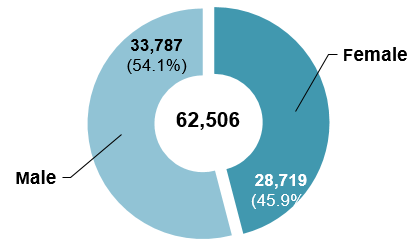
| Female | Male | Total |
|---|---|---|
| 45.9% | 54.1% | 100.0% |
| 28,719 | 33,787 | 62,506 |
Figure 2: Total population
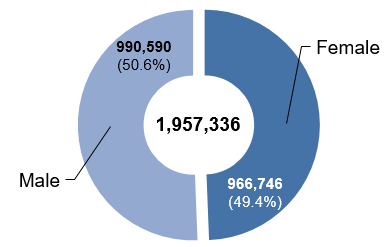
| Female | Male | Total |
|---|---|---|
| 49.4% | 50.6% | 100.0% |
| 966,746 | 990,590 | 1,957,336 |
Figure 3: Age-specific prevalence of disability (in percentage)

| Female | Male | Total | |
|---|---|---|---|
| 0-14 | 1.0 | 1.2 | 1.1 |
| 15-24 | 1.8 | 2.1 | 2.0 |
| 25-44 | 1.9 | 2.8 | 2.4 |
| 45-64 | 7.3 | 8.4 | 7.8 |
| 65+ | 28.0 | 27.0 | 27.5 |
| Total | 3.0 | 3.4 | 3.2 |
Figure 4: Age distribution of persons with disabilities (in percentage)

| Female | Male | Total | |
|---|---|---|---|
| 0-14 | 11.2 | 12.5 | 11.9 |
| 15-24 | 14.9 | 15.4 | 15.2 |
| 25-44 | 17.5 | 22.4 | 20.2 |
| 45-64 | 23.6 | 21.7 | 22.5 |
| 65+ | 32.7 | 28.1 | 30.2 |
Type of disability / difficulty (in percentage)
| Female | Male | Total | |||||||
|---|---|---|---|---|---|---|---|---|---|
| Seeing, even with glasses | 33.1 | 34.6 | 33.9 | ||||||
| Hearing, even with hearing aid | 7.3 | 7.1 | 7.2 | ||||||
| Walking / climbing up steps | 29.3 | 24.7 | 26.8 | ||||||
| Remembering or concentrating | 7.6 | 9.7 | 8.7 | ||||||
| Self-care | 12.7 | 11.8 | 12.2 | ||||||
| Communicating in normal language | 4.7 | 5.7 | 5.2 | ||||||
| Movement of the upper body | 5.2 | 6.5 | 5.9 | ||||||
Cause of disability / difficulty (in percentage)
| Female | Male | Total | |||||||
|---|---|---|---|---|---|---|---|---|---|
| Congenital | 29.4 | 33.1 | 31.4 | ||||||
| Disease | 28.5 | 27.6 | 28 | ||||||
| Road traffic accident | 2.1 | 7.1 | 4.8 | ||||||
| Work-related accident | 0.7 | 2.6 | 1.7 | ||||||
| Old age | 35.3 | 25.5 | 30 | ||||||
| Other causes | 4 | 4.1 | 4.1 | ||||||
Figure 5: Persons with disabilities by geographical location (in percentage)
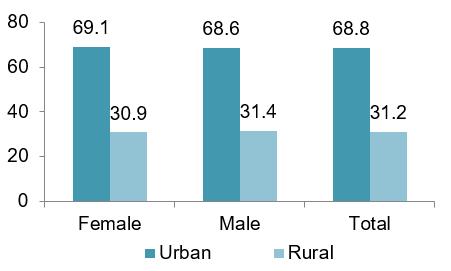
| Female | Male | Total | |
|---|---|---|---|
| Urban | 69.1 | 68.6 | 68.8 |
| Rural | 30.9 | 31.4 | 31.2 |
Figure 6: Total population by geographical location (in percentage)
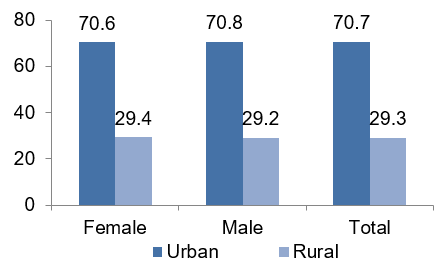
| Female | Male | Total | |
|---|---|---|---|
| Urban | 70.6 | 70.8 | 70.7 |
| Rural | 29.4 | 29.2 | 29.3 |
Figure 7: Persons with disabilities (15 years and above) by marital status (in percentage)
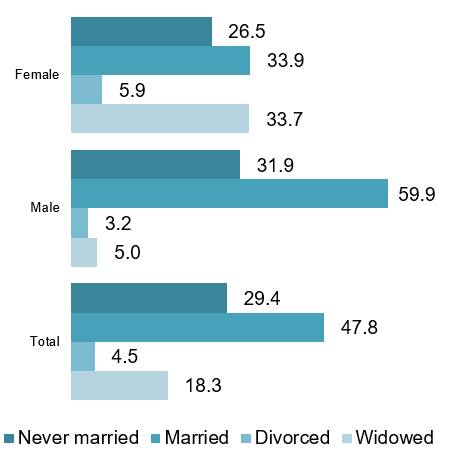
| Female | Male | Total | |
|---|---|---|---|
| Never married | 26.5 | 31.9 | 29.4 |
| Married | 33.9 | 59.9 | 47.8 |
| Divorced | 5.9 | 3.2 | 4.5 |
| Widowed | 33.7 | 5.0 | 18.3 |
Figure 8: Total population (15 years and above) by marital status (in percentage)
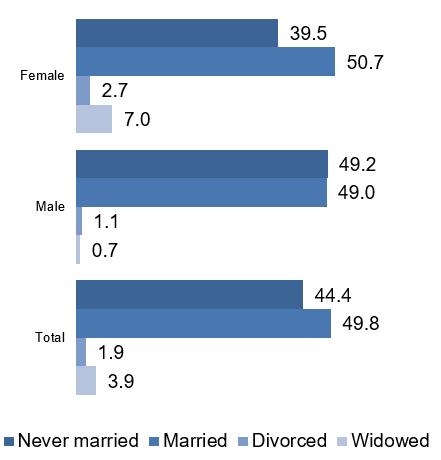
| Female | Male | Total | |
|---|---|---|---|
| Never married | 39.5 | 49.2 | 44.4 |
| Married | 50.7 | 49.0 | 49.8 |
| Divorced | 2.7 | 1.1 | 1.9 |
| Widowed | 7.0 | 0.7 | 3.9 |
Persons with disabilities (15 years and above) by educational attainment (in percentage)
| Female | Male | Total | |||||||
|---|---|---|---|---|---|---|---|---|---|
| Illiterate | 68.5 | 46.0 | 56.4 | ||||||
| Read and write | 8.3 | 17.2 | 13.1 | ||||||
| Pre-secondary | 11.2 | 19.8 | 15.8 | ||||||
| Secondary | 8.8 | 12.3 | 10.6 | ||||||
| Diploma | 1.6 | 2.2 | 1.9 | ||||||
| University | 1.6 | 2.1 | 1.8 | ||||||
| Master | 0.1 | 0.4 | 0.2 | ||||||
| Doctorate | 0.0 | 0.1 | 0.1 | ||||||
Total population (15 years and above) by educational attainment (in percentage)
| Female | Male | Total | |||||||
|---|---|---|---|---|---|---|---|---|---|
| Illiterate | 19.4 | 8.9 | 14.1 | ||||||
| Read and write | 7.0 | 7.2 | 7.1 | ||||||
| Primary | 10.5 | 12.4 | 11.4 | ||||||
| Preparatory | 15.8 | 19.8 | 17.8 | ||||||
| Secondary | 33.6 | 37.5 | 35.6 | ||||||
| Diploma | 5.8 | 5.9 | 5.8 | ||||||
| University | 7.5 | 7.0 | 7.3 | ||||||
| Master | 0.4 | 1.0 | 0.7 | ||||||
| Doctorate | 0.1 | 0.2 | 0.1 | ||||||
Figure 9: Persons with disabilities (15 years and above) by economic activity (in percentage)

| Female | Male | Total | |
|---|---|---|---|
| Working | 4.8 | 23.7 | 14.9 |
| Unemployed | 2.7 | 6.1 | 4.5 |
| Student | 5.6 | 5.3 | 5.4 |
| Homemaker | 39.6 | 0.9 | 18.8 |
| Self-sufficient | 1.5 | 12.8 | 7.6 |
| Unable to work | 45.8 | 51.1 | 48.7 |
Figure 10: Total population (15 years and above) by economic activity (in percentage)

| Female | Male | Total | |
|---|---|---|---|
| Working | 15.5 | 54.7 | 35.3 |
| Unemployed | 9.7 | 13.0 | 11.4 |
| Student | 19.6 | 20.3 | 20.0 |
| Homemaker | 50.3 | 0.7 | 25.3 |
| Self-sufficient | 0.6 | 5.5 | 3.0 |
| Unable to work | 4.3 | 5.8 | 5.0 |
Source: National Centre for Statistics and Information (2010).
| Convention | Signed | 17.3.2008 |
|---|---|---|
| Ratified / Acceded | 5.11.2008 | |
| Optional Protocol | Signed | No |
| Ratified / Acceded | No |
Source: UN (2014); Sultanate Decree No. 121 on Oman’s ratification of the International Convention on the Rights of Persons with Disabilities (2008).
| National coordination mechanism: | Name: | National Committee for the Welfare of the Disabled |
|---|---|---|
| Year established: | 2008 | |
| Chair: | Minister of Social Development | |
| Persons with disabilities represented? | Yes | |
| Additional mechanisms: | System of focal points for disability related matters in line ministries or other governmental institutions | |
| National Committee for the Welfare of the Disabled | ||
NATIONAL DEFINITION OF DISABILITY / PERSONS WITH DISABILITIES
The person who suffers from a deficiency in some of their sensory, physical or mental capacities, be it congenital, or the result of a hereditary factor, disease or accident, which limits their ability to perform their natural role in life in comparison to those of the same age, and which results in the need for special care and rehabilitation in order to assume their role in life (Sultanate Decree No. 63 on the Law on Care and Rehabilitation of the Disabled, 2008).
| Articles on disability included in the constitution? | Yes |
|---|---|
| General / overarching national disability law | Sultanate Decree No. 63 on the Law on Care and Rehabilitation of the Disabled (2008) |
| National disability strategy / plan | CBD |
Source: ESCWA, based on data collected from government focal points through the ESCWA Questionnaire on the Implementation of the Convention on the Rights of Persons with Disabilities and the Arab Decade for Persons with Disabilities (2013).
Footnotes:
1 All data pertains to nationals only.